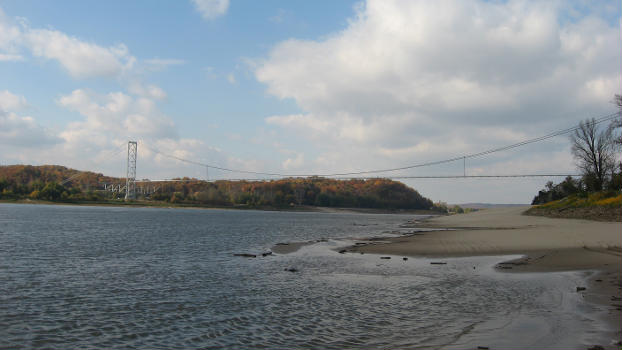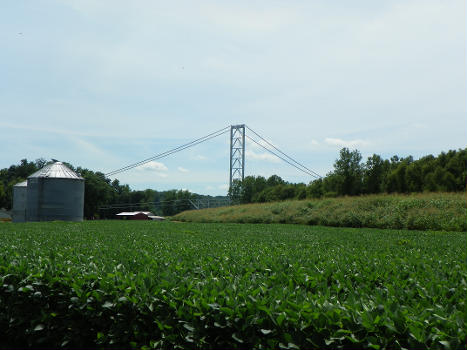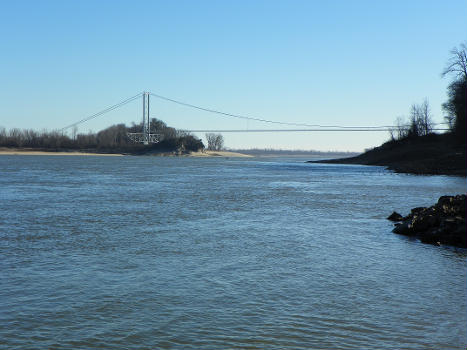General Information
| Completion: | 17 June 1955 |
|---|---|
| Status: | in use |
Project Type
| Structure: |
Single-span two-tower suspension bridge |
|---|---|
| Function / usage: |
Gas pipeline bridge |
| Material: |
Steel bridge |
| Plan view: |
Structurae Plus/Pro - Subscribe Now! |
| Material: |
Structurae Plus/Pro - Subscribe Now! |
| Secondary structure(s): |
Structurae Plus/Pro - Subscribe Now! |
Location
| Location: |
Grand Tower, Jackson County, Illinois, USA Perry County, Missouri, USA |
|---|---|
| Crosses: |
|
| Coordinates: | 37° 38' 32" N 89° 31' 3" W |
Technical Information
Dimensions
| main span | 655 m | |
| pylons | number | 2 |
Materials
| cables |
steel wire
|
|---|---|
| pylons |
steel
|
| anchorages |
reinforced concrete
|
Excerpt from Wikipedia
The Grand Tower Pipeline Bridge is a suspension bridge carrying a natural gas pipeline across the Mississippi River between Wittenberg, Missouri and Grand Tower, Illinois.
Construction
Although construction of a natural gas pipeline under the Mississippi River would have been cheaper, this option would have created great difficulty in handling any leaks and maintenance, so it was decided to construct a bridge to carry the gas pipeline. The bridge was the first pipeline suspension bridge to cross the Mississippi River. It was constructed for the Texas-Illinois Natural Gas Pipeline company for an estimated $3,800,000 in 1953. It was the final piece in the construction of a natural gas pipeline transporting gas from Corpus Christi, Texas to Chicago, Illinois and Detroit, Michigan which carries 500 million cubic feet of gas a day at a pressure of 850 pounds of pressure per square inch. Work began in September, 1953. The bridge features two 266 foot tall steel framework towers, one on each side of the river. Vertical steel suspender cables connect the twin 30 inch pipelines to the main suspension cables, at a height of 115 feet above the river. During construction the 80 foot long pipes were stretched out across the river where welders connected them together. Each pipe weighs 5 tons and it took 72 pipes to span the river, adding to around 360 tons of dead weight. The abutments to support this weight go to the bedrock, 50 feet deep on the Illinois side and 154 feet on the Missouri side. The site at Grand Tower/Wittenberg was chosen because the river is narrow and deep there, and the limestone bedrock could be easily reached.
Text imported from Wikipedia article "Grand Tower Pipeline Bridge" and modified on July 23, 2019 according to the CC-BY-SA 4.0 International license.
Participants
Currently there is no information available about persons or companies having participated in this project.
Relevant Web Sites
- About this
data sheet - Structure-ID
20008138 - Published on:
12/02/2003 - Last updated on:
08/11/2024







